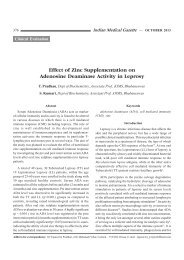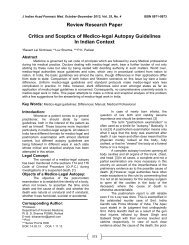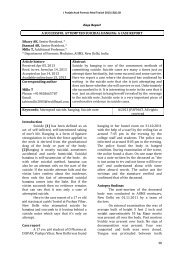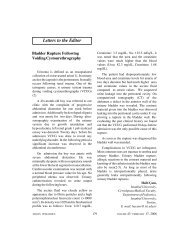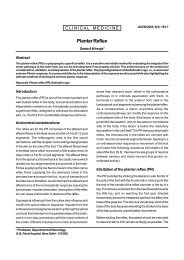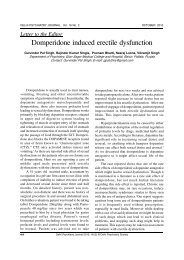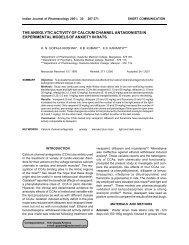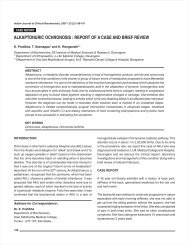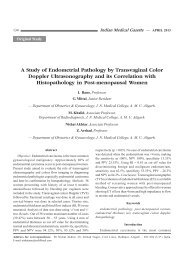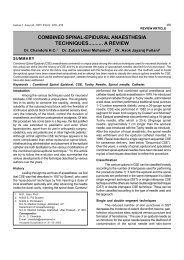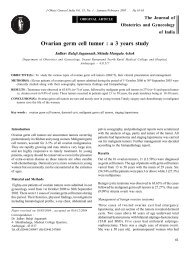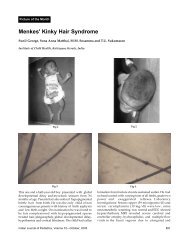Diabetic Neuropathy: Current Concepts - medIND
Diabetic Neuropathy: Current Concepts - medIND
Diabetic Neuropathy: Current Concepts - medIND
You also want an ePaper? Increase the reach of your titles
YUMPU automatically turns print PDFs into web optimized ePapers that Google loves.
are cases. Its symptoms are extremely variable,<br />
ranging from severely painful symptoms at one<br />
extreme to the completely painless variety, which<br />
may present with an insensitive foot ulcer at the<br />
other end. The neuropathic symptoms may be<br />
positive or negative. The negative symptoms are -<br />
numbness and deadness in the lower limbs while<br />
the positive symptoms most commonly include<br />
burning pain, altered and uncomfortable<br />
temperature perception, paraesthesia, shooting,<br />
stabbing and lancinating pain, hyperaesthesia and<br />
allodynia. The feet and legs are most commonly<br />
affected, rarely less severe similar symptoms are<br />
experienced in the upper limbs also.<br />
The sensory symptoms and signs are more<br />
common than motor symptoms and signs.<br />
Common motor signs are absent or reduced ankle<br />
reflex, and minimal distal muscle weakness. Motor<br />
involvement results in foot deformity. This<br />
abnormality redistributes weight bearing and leads<br />
to callus and ulcer formation. The proprioceptive<br />
loss makes the gait more unsteady and there is a<br />
sense of walking on cotton wool.<br />
Acute painful neuropathy is a distinct variant of<br />
distal sensory neuropathy 8 , presenting acutely with<br />
severe sensory symptoms with few sensory or<br />
motor signs and often it follows a period of flux in<br />
glycaemic control.<br />
2. Autonomic neuropathy<br />
Autonomic neuropathy is a serious and often overlooked<br />
component of diabetic neuropathy. Any<br />
organ of body which is supplied by autonomic<br />
nerves can be affected. Studies have confirmed<br />
the presence of parasympathetic dysfuction in 65%<br />
of the type 2 diabetic patients 10 years after<br />
diagnosis and of combined parasympathetic and<br />
sympathetic neuropathy in 15.2% 9 . Autonomic<br />
neuropathy is not simply an “all or none”<br />
phenomenon and its symptoms range from minor<br />
to severe. The severe form may affect survival and<br />
can cause sudden death. Among autonomic<br />
neuropathic symptoms gustatory sweating is most<br />
common, followed by postural hypotension and<br />
diarrhoea 10 . Loss of sweating in the feet, sexual<br />
dysfunction, bladder abnormalities, and<br />
gastroparesis may also occur (Table II).<br />
Table II : Symptoms and signs of autonomic<br />
neuropathy.<br />
1. Cardiovascular<br />
Postural hypotension<br />
Resting tachycardia<br />
Painless myocardial infarction<br />
Sudden death (with or without association<br />
with general anaesthesia)<br />
Prolonged QT interval<br />
2. Gastrointestinal<br />
Oesophageal motor incoordination<br />
Gastric dysrhythmia, hypomotility<br />
(gastroparesis diabeticorum)<br />
Pylorospasm.<br />
Uncoordinated intestinal motility (diabetic<br />
diarrhoea, spasm)<br />
Intestinal hypomotility (constipation)<br />
Gallbladder hypocontraction (diabetic<br />
cholecystopathy)<br />
Anorectal dysfunction (faecal incontinence)<br />
3. Genitourinary<br />
<strong>Diabetic</strong> cystopathy (impaired bladder<br />
sensation, atonic bladder, post micturition<br />
dribbling, detrusor hyporeflexia or<br />
hyperreflexia)<br />
Male impotence<br />
Ejaculatory disorders<br />
Reduced vaginal lubrication, dyspareunia<br />
4. Respiratory<br />
Impaired breathing control (?)<br />
Sleep apnoea ?<br />
5. Thermoregulatory<br />
Sudomotor<br />
Vasomotor<br />
6. Pupillary<br />
Miosis<br />
Disturbances of dilatation<br />
Argyll Robertson pupil<br />
306 Journal, Indian Academy of Clinical Medicine Vol. 2, No. 4 October-December 2001



